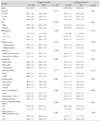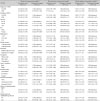1. Craig JP, Nichols KK, Akpek EK, et al. TFOS DEWS II definition and classification report. Ocul Surf. 2017; 15:276–283.


2. Fergusson JE. The heavy elements: chemistry, environmental impact, and health effects. Oxford: Pergamon Press;1990. p. 614.
3. He ZL, Yang XE, Stoffella PJ. Trace elements in agroecosystems and impacts on the environment. J Trace Elem Med Biol. 2005; 19:125–140.


4. Bradl H. Heavy metals in the environment: origin, interaction and remediation. Amsterdam: Elsevier Academic Press;2005. p. 1–25.
5. Tchounwou PB, Yedjou CG, Patlolla AK, Sutton DJ. Heavy metal toxicity and the environment. In : Luch A, editor. Molecular, clinical and environmental toxicology. . Basel: Springer;2012. p. 133–164.
6. Lee SH, Kang EM, Kim GA, et al. Three toxic heavy metals in open-angle glaucoma with low-teen and high-teen intraocular pressure: a cross-sectional study from South Korea. PLoS One. 2016; 11:e0164983.

7. Chung SH, Myong JP. Are higher blood mercury levels associated with dry eye symptoms in adult Koreans? A population-based cross-sectional study. BMJ Open. 2016; 6:e010985.

10. Bhan A, Sarkar NN. Mercury in the environment: effect on health and reproduction. Rev Environ Health. 2005; 20:39–56.


11. Warfvinge K, Bruun A. Mercury distribution in the squirrel monkey retina after in Utero exposure to mercury vapor. Environ Res. 2000; 83:102–109.


13. Tanan CL, Ventura DF, de Souza JM, et al. Effects of mercury intoxication on the response of horizontal cells of the retina of thraira fish (Hoplias malabaricus). Braz J Med Biol Res. 2006; 39:987–995.


14. Cavalleri A, Belotti L, Gobba F, et al. Colour vision loss in workers exposed to elemental mercury vapour. Toxicol Lett. 1995; 77:351–356.


15. Sabelaish S, Hilmi G. Ocular manifestations of mercury poisoning. Bull World Health Organ. 1976; 53:suppl. 83–86.
16. Botelho SY, Hisada M, Fuenmayor N. Functional innervation of the lacrimal gland in the cat. Origin of secretomotor fibers in the lacrimal nerve. Arch Ophthalmol. 1966; 76:581–588.

17. Sibony PA, Walcott B, McKeon C, Jakobiec FA. Vasoactive intestinal polypeptide and the innervation of the human lacrimal gland. Arch Ophthalmol. 1988; 106:1085–1088.


18. Dartt DA. Neural regulation of lacrimal gland secretory processes: relevance in dry eye diseases. Prog Retin Eye Res. 2009; 28:155–177.

19. Milioni AL, Nagy BV, Moura AL, et al. Neurotoxic impact of mercury on the central nervous system evaluated by neuropsychological tests and on the autonomic nervous system evaluated by dynamic pupillometry. Neurotoxicology. 2017; 59:263–269.


20. Augustin AJ, Spitznas M, Kaviani N, et al. Oxidative reactions in the tear fluid of patients suffering from dry eyes. Graefes Arch Clin Exp Ophthalmol. 1995; 233:694–698.


21. Nabi S. Mercury as a source of reactive oxygen species. In : Nabi S, editor. Toxic effects of mercury. [place unknown]: Springer;2014. p. 95–99.
22. Hessen M, Akpek EK. Dry eye: an inflammatory ocular disease. J Ophthalmic Vis Res. 2014; 9:240–250.


23. Fortes MB, Diment BC, Di Felice U, et al. Tear fluid osmolarity as a potential marker of hydration status. Med Sci Sports Exerc. 2011; 43:1590–1597.


24. Walsh NP, Fortes MB, Esmaeelpour M. Influence of modest changes in whole-body hydration on tear fluid osmolarity: important considerations for dry eye disease detection. Cornea. 2011; 30:1517.


25. Walsh NP, Fortes MB, Raymond-Barker P, et al. Is wholebody hydration an important consideration in dry eye? Invest Ophthalmol Vis Sci. 2012; 53:6622–6627.

26. The definition and classification of dry eye disease: report of the Definition and Classification Subcommittee of the International Dry Eye WorkShop (2007). Ocul Surf. 2007; 5:75–92.

27. Research in dry eye: report of the Research Subcommittee of the International Dry Eye WorkShop (2007). Ocul Surf. 2007; 5:179–193.

28. Brake J, Hester PY, Thaxton P, et al. Effect of mercury toxiocity on serum osmolality, plasma sodium and potassium, and serum proteins in the chicken. Arch Environ Contam Toxicol. 1980; 9:431–436.

29. Erie JC, Butz JA, Good JA, et al. Heavy metal concentrations in human eyes. Am J Ophthalmol. 2005; 139:888–893.


30. Bhattacharyya MH, Wilson AK, Rajan SS, Jonah M. Biochemical pathways in cadmium toxicity. In : Zalup RK, Koropatnick J, editors. Molecular biology and toxicology of metals. London: Taylor & Francis;2000. p. 1–74.
31. Beatty S, Koh H, Phil M, et al. The role of oxidative stress in the pathogenesis of age-related macular degeneration. Surv Ophthalmol. 2000; 45:115–134.


32. Hahn P, Milam AH, Dunaief JL. Maculas affected by age-related macular degeneration contain increased chelatable iron in the retinal pigment epithelium and Bruch's membrane. Arch Ophthalmol. 2003; 121:1099–1105.


33. Tsubota K, Kawashima M, Inaba T, et al. The antiaging approach for the treatment of dry eye. Cornea. 2012; 31:Suppl 1. S3–S8.

34. Hirayama K, Yasutake A. Sex and age differences in mercury distribution and excretion in methylmercury-administered mice. J Toxicol Environ Health. 1986; 18:49–60.


35. Thomas DJ, Fisher HL, Sumler MR, et al. Sexual differences in the distribution and retention of organic and inorganic mercury in methyl mercury-treated rats. Environ Res. 1986; 41:219–234.


36. Stapleton F, Alves M, Bunya VY, et al. TFOS DEWS II epidemiology report. Ocul Surf. 2017; 15:334–365.








 PDF
PDF ePub
ePub Citation
Citation Print
Print




 XML Download
XML Download